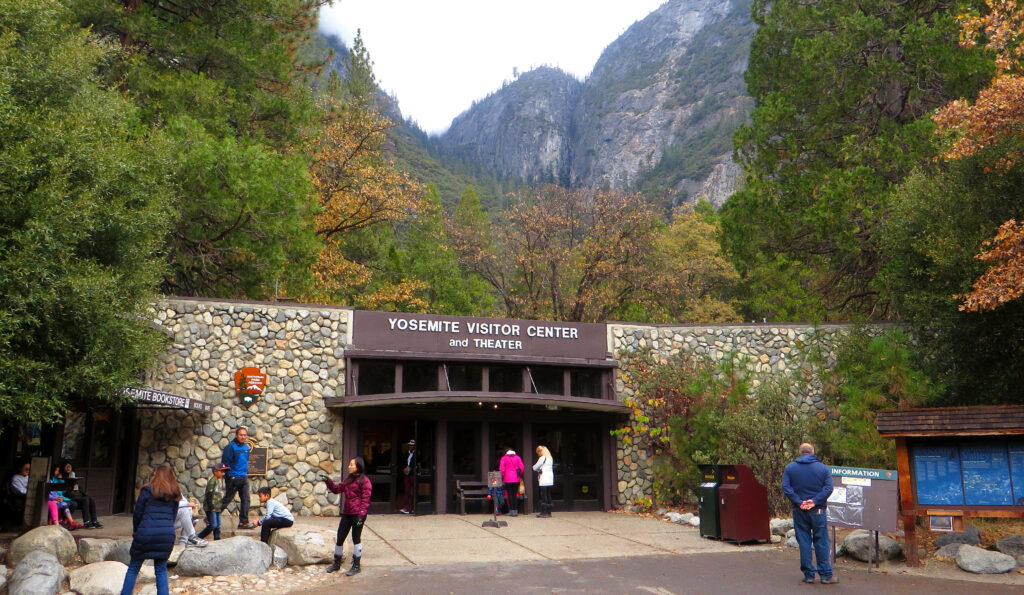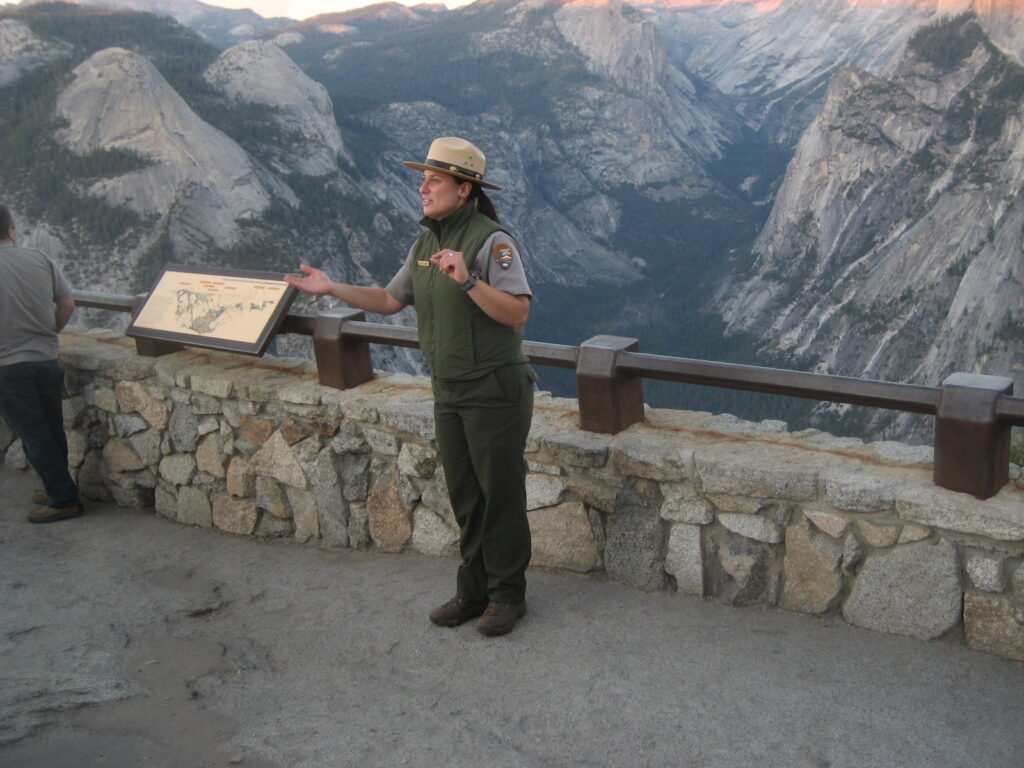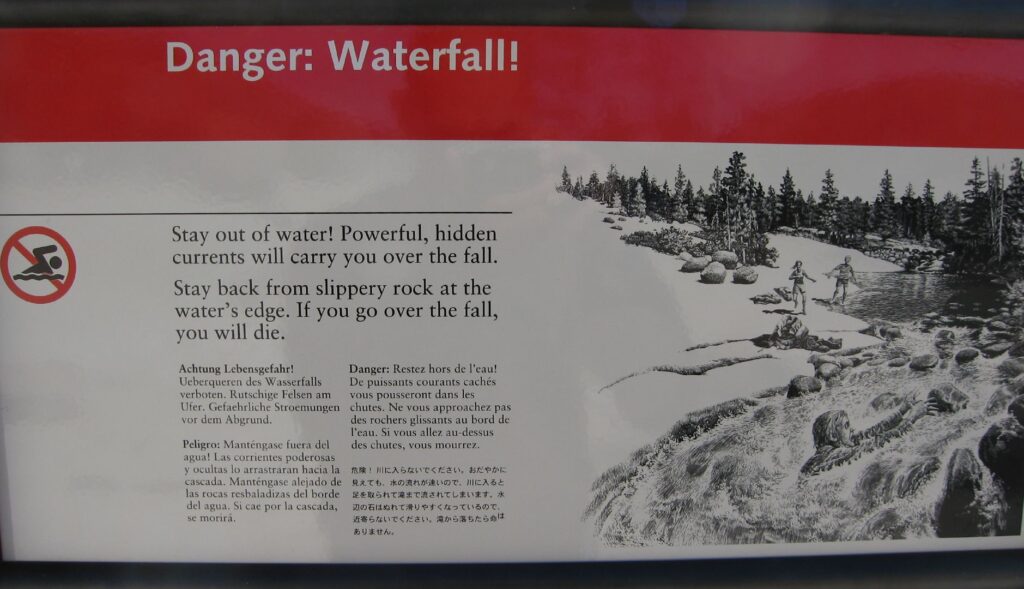Visitor Centers and Public Lands
Visitor Centers and Public Lands
By Erin Trombley
Have you ever visited one of our beautiful national parks? If so, you may have noticed a visitor center near the entrance. Why are there so many visitor centers near public lands? How are they funded? What do they do?
Most public land visitor centers provide a range of information and services that may include:
- Parking
- Public restrooms
- Food, beverages, snacks
- Souvenirs, gift items, etc.
- Maps and guidebooks for sale
- Guided walks or other educational programs
- Sale of passes, camping gear, hunting/fishing licenses
- Safety information relevant to the location and/or time of year
- A ranger or other professional staff with expertise on topics relevant to visitor activities
- A display or museum space that showcases local geology, animals, plants, and/or ecosystems

Visitor centers increase high-quality outdoor experiences. A huge part of their purpose is to provide context for what you’re about to see, and to ensure you’re equipped to successfully enjoy the public land. To successfully enjoy the land means to visit without injury, without the need for rescue, and with minimal impact on the land, plants and animals that live there.
To achieve this, visitor centers prepare guests for what they’ll experience. Informational displays or museum space can describe history, land characteristics, notable flora and fauna, and much more. Not only are they interesting, they raise visitor awareness so that when they’re in the park, they can recognize the sensitive plants, for example, that shouldn’t be walked on, wildlife that requires special precautions, or the telltale signs of geological hazards to avoid such as dangerous terrain.
Gear and equipment for sale at an information center are also there to ensure guests are well-equipped for their visit. Whether it’s a bear canister needed for food and toiletries, or snowshoes for deep snow, information centers will frequently offer essentials to make sure visitors have what they need. That includes expert advice. An educated staff person on-hand to answer questions or help hash out details of a planned excursion can help guide decisions before someone embarks on an outing, or steer the visitor toward gear they didn’t know they needed.
Educational programming offered at visitor centers is the next level of preparing visitors for what awaits on public land. Whether it’s a birding program, or a Wilderness First Aid (WFA) course, educational programs increase visitor awareness and knowledge. In the case of birding, for example, the program can make you aware of the types of birds living there, how to identify them, and what their habits are. You’re also likely to learn how feeding the birds (purposely or accidentally) changes their natural behavior and can lead to increased sickness in the bird population. A WFA course, on the other end of the spectrum, can make the participant more cognizant of physical hazards visitors may encounter in this space, the types of injury that can result, and how best to help.

Outside of the visitor center, interpretive and educational signage on the land is another layer of information aimed at reducing impacts and improving visitor safety. Staff and volunteers out on the land are additional points of contact providing information and attempting to reduce impacts and mishaps.

Visitor centers also benefit state and local economies significantly. The National Park Service reported that in 2021, 12 million visitors spent $452 million in gateway regions visiting national park facilities just in New York, which supported over 4,600 jobs. And these figures don’t include the Adirondack or Catskill Parks, which are not national parks.

All this information about national park visitor centers illustrates their impact when consistent services and information are offered. Having greater contact with recreators means fewer injuries, fewer rescues, fewer human impacts, and a better overall visitor experience. Regular investment of government funds makes that level of consistency possible. Adirondack Park visitor, information, and welcome centers are not funded in the same way. As a result, we have a patchwork of services and information at facilities owned and operated by an array of private nonprofit organizations, colleges, local government departments, chambers of commerce, and private individuals, all striving to meet the various needs of visitors and the community in their own ways.
How can we do this better?
The Adirondack Park is the largest protected land in the contiguous United States at six million acres, with 13 million annual visitors. The park is larger than Grand Canyon, Yellowstone, Everglades, and Glacier National Parks combined, and 1/3 the size of New York State, with entrances on all sides. To adequately prepare visitors to enter this vast, gorgeous landscape, a network of visitor centers offering the same types of information and services proven effective across the country at national park visitor centers is needed.
Similarly, the Catskill Park, at 600,000 acres, receives 12 million visitors annually. 25 million people visit the parks of the New York State Forest Preserve each year, yet we do not have a well-funded, consistent network of visitor centers to prepare people for success on our protected, public land.
Leading by example, Cascade Welcome Center and High Peaks Information Center, owned and operated by ADK, offer the educational information, programs, gear and equipment, interpretive signage, expert staff, field staff and volunteers on par with the national park model in the Adirondacks. The Catskills Visitor Center in Mt. Tremper, NY, which is a program of the nonprofit Catskill Center, offers a similar level of services, programs, and amenities to try to reduce the impacts of millions of visitors to their park.
That’s why ADK is partnering with Catskill Center, Paul Smith’s VIC, and SUNY ESF Adirondack Interpretive Center to call on New York State to make a greater investment in Adirondack Park and Catskill Park visitor centers. We must increase the reach of services and information proven so critically effective in managing the ever-growing population of visitors to these public lands and their needs.
Click here to contact your legislators and the governor to let them know you support increased visitor center funding to protect the lands of the Forest Preserve.
Related
ADK Applauds Updates to Adirondack Park State Land Master Plan
ADK appreciates the Adirondack Park Agency’s (APA) recent updates to the proposed final amendments to […]
Forest Preserve Advocates Applaud Final 2025–26 Budget
May 13, 2025–Albany, NY: Over forty organizations and municipalities advocating for New York’s Forest Preserves […]
Adirondack Conservation Organizations Urge Park Agency to Drop Controversial Motor-Vehicle Plan
February 17, 2025 — Ray Brook, NY — Adirondack conservation organizations today said they were […]
ADK Advocates for the EPF
February 10, 2025—Adirondack Mountain Club (ADK) staff spent the day at the Albany Capitol during […]

